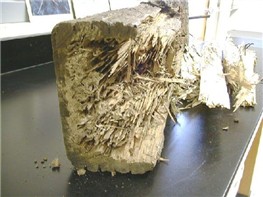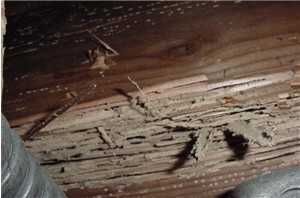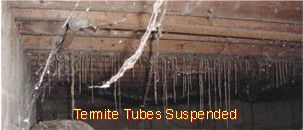WATCH AND HEAR LIVE TERMITES IN ACTION
Click the computer screen

ACTUAL SIZE OF A LIVE TERMITE NEXT TO A DIME
Of all Wood Boring insects, Termites are definitely the most damaging wood destroying insects out there. Did you know that the average single-family home has as many as three to four termite colonies beneath it (and each colony contains as many as 1 million winged residents). It's very important to prevent these colonies from attacking your home and causing extensive structural damage.
TERMITE DAMAGE TO STRUCTURAL MEMBERS


Termites must remain in moist areas in order to survive (which I will get into more detail next). Once they arrive into an open space they build mud tunnels in order to remain in a moist environment. The smallest of cracks in your foundation -- usually a basement or concrete slab -- is enough for those sneaky little termites to gain entry into your home. They will utilize the cracks to gain access to the wood framing because it's much easier for them to use naturally occuring cracks than to build mud tunnels to protect themselves from the dry environment. Once they're inside your home, anything made of wood -- from framing within the structure (especially sills), window and door frames to subfloors to furniture -- is fair game. You're not able to visibly see termites because they feed undetected. Termite workers attack the wood in your home from the inside out and infestations can go undiscovered until the wood is almost completely destroyed, which could take many years.

As if this scenario weren't bad enough, after they feast on your structure, termites leave behind a chemical trail that sends signals to other termites that food is near. Once started, this trail of destruction is impossible to stop without the services of a professional exterminator who is skilled at locating the hidden regions of your home where these termites take up residence. Wood-boring insects are difficult to control by homeowners once an infestation has begun. Treating insects is not a do-it-yourself project. If you have signs of Termite activity, do yourself a favor, hire a professional exterminator for full treatment.
WHAT ARE TERMITES ATTRACTED TO, BESIDES WOOD?
It's Moisture. It's extremely difficult to ward off moisture throughout your home, and especially underneath it, where termites gain initial entry to your property. It's impossible to dry out areas under your home. The good news is that in many cases, the problem starts in areas you can reach (outside and around your home), where wood products are exposed to the elements and thus trap moisture. Prevention is the best management method.
HERE'S HOW YOU CAN PROTECT YOUR HOME AGAINST TERMITES:
Above all, schedule an annual termite inspection and watch for mud tunnels over exposed exterior surfaces of your home (especially the foundation) and monitor for swarming termites in April and May.
Trim all shrubs, bushes, vines and other dense greenery away from the foundation and the siding of your home. Any vegetation touching your home will give Termites easy access to the structure. They simply make their trail behind the vines and vegetation to protect them from sunlight.
So many homeowners collect big piles of firewood outside their homes come wintertime. But some of us who don't use the entire pile let it sit throughout the rest of the year. This does you no good for many reasons. First, the firewood begins to rot as it's exposed to changes in the weather; second, it's ultimately useless because it becomes wet with moisture; and third (and most important), it's a magnet for termites seeking a home. You'll obviously need to store some firewood outdoors during the winter months -- particularly if you light fires often -- so your best bet is to keep the pile raised off the ground and away from the side of your house. Also, try to keep it protected from rain.
Consistent with the reasoning of the above-listed point, remove all lumber, tree stumps and any other variety of wood from the parameters of your home. If you're saving some wood for that home-improvement project you're planning to tackle on a rainy day, store it in your garage in a high and dry area. No wood should be touching the ground around your house, period. Including all exterior finishes (the siding) of your home. These areas should be 6 to 8 inches above grading.
This includes removal and replacement of any wood posts or stair stringers that penetrate concrete floors or rest on dirt on the exterior of the home or in the basement or crawl space. These penetrations will only invite Termites and provide avenues for their passage to more appetizing segments of the structure.
If you've got leaky pipes or any accumulation of water underneath your home, call a professional (or tackle the job yourself if you're capable). If you've been putting off the job, don't stall any longer. You may already have attracted termites to the water. By the same token, if you find standing water anywhere -- inside or outside your home -- remedy the problem and get rid of the moisture immediately. (Please read "Wet Basements" for more detailed information).
Clean all your gutters and downspouts regularly. Clogs and other obstructions will cause the gutters to overflow resulting in moist grading around your foundation which will attract termite populations. Inspect your gutters regularly for signs of disrepair. Inspect your home's crawl space you have one. It may be in your best interest to determine if the space is properly protected in order to stave off Termites. Moisture and humidity in crawl spaces can be reduced by installing a 4-6 mil polyethylene sheeting over the soil surface. This cover will act as a vapor barrier to reduce evaporation from the soil and condensation of moisture on floor joists and sub flooring. (Please read "Your Crawl Space" for more detailed information).
Since Termites can prey on the outside of your home, inspect your home regularly for any foundation cracks. If you find cracks inside or outside, seal them immediately. Ensure that your home receives continual maintenance to keep its exterior paint in good condition. Chipping, peeling paint can increase the likelihood of termite infestation due to moisture accumulation on unprotected wood.
As a homeowner, you can never prevent termite infestation with 100 percent certainty. However, you can take these various measures to decrease the probability of an infestation in your home. Considering both the cost of damage and inspection/extermination, you have absolutely nothing to lose by attempting to perform every one of these precautions. Yes, it is true that Termites may find a meal at your house eventually, but they are not the only pests ready to eat your house. Remember...there are two types of homes out there, homes that have been infested with Termites and homes that have not been infested with Termites...YET.



Comments(0)